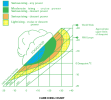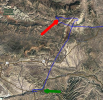Lndwarrior
Cleared for Takeoff
- Joined
- Jan 15, 2009
- Messages
- 1,283
- Display Name
Display name:
Gary
I've been flying recreationally for over 30 years. Mind you 20 of those was pretty much the same 1 hour flight.
I'm on multiple aviation forums every single day, multiple times, for years now. I read all the accident reports. I use checklists (mostly). I am extremely safety conscious.
And today I was (mostly) an idiot - and my precious wife was in the plane.
Plane is my homebuilt Zenith CH601 XLB with an Lyco O-235-C1 engine, MA-3A carb, dual electric fuel pumps. I've put almost 600 hours on on her.
Today, wifey and I decide to take a scenic flight over the foothills of the Sierras where we live. We take off from Pine Mountain Lake (E45), marvel at the snow-capped Sierra's in the near distance, and cruise over Don Pedro Reservoir around 5000 feet agl.. Plane is running great in the cool, smooth air. The foothills are green and beautiful. I practice some slow flight as we head toward Calaveras County Airport and decide to do a landing. Prior to landing I pull the carb heat, as always, and make a decent landing.
We take off again, heading back to E45, with the power set at 2450 cruise rpm. We're up about 4000 agl just past Columbia Airport when I get the feeling the engine is running just a little rough. Am I imagining this? I pay more attention and it does seem like its running not quite right. So push the throttle in watching the tach to get it up to 2600 rpm or so. There's a slight stumble, but zero rpm increase.
I pull the throttle back and then forward again and the same thing happens. The engine does sound a little rough (though my wife did not notice it) but there is definitely something wrong with the engine. I pull the power back to 2400 and it seems reasonably smooth.
Yeah, with the clouds forming below us, temps in the low 40s, every damn rookie pilot in the world is thinking, "Pull the carb heat, idiot!".
Guess what I didn't do???
Well, I wasn't a complete idiot because all I thought about at that point was that we were within gliding distance of Columbia Airport. I rolled the plane into a 180, forgot to change to the airport frequency (Bro! You're on Guard!). F**k, mistake number 2. Change to the airport frequency and announce my position. The engine is running smoothly at this point and I dont touch anything until we're high abeam the numbers and know I have the runway made.
I landed long (telling wifey, I am NOT coming up short!) and pulled off the runway. Did a full power runup, no issues. Check both mags, no issues. Checked EGT and CHT (in the air beforehand as well), no issues. Check the fuel pressure, no issues. We sat there for a while, did a long taxi, another full power runup and no issues. AND I STILL DIDN'T THINK OF CARB ICE!!! Don't ever fly with me, I'm an idiot...
E45 is about 20 miles from Columbia so I make the decision to climb up to 7500 msl above Columbia Airport before heading back to E45. I want as much altitude in case something goes wrong.
I decide that a straight in to runway 09 at E45 is going to be the shortest route to getting on the ground. I stay up way high until 3 miles out then I pull carb heat before reducing the throttle - and the friggen light finally goes off in my brain - carb ice.
I'm still beating myself up wondering how the hell this didn't cross my mind beforehand. It's no excuse, but in 30 years of flying I've never experienced carb ice.
Yet, I still can't understand why that wasn't the FIRST thought on my mind? I am getting older and maybe this is a sign that it's time for me to reconsider continuing with this passion of mine. I just see no way of letting myself off the hook for this.
If I had been flying by myself, I may not be so concerned about my actions, However, my precious wife was in the plane and she deserves a better pilot than this. What if we hadn't been in gliding distance of an airport and it had got worse and I still didn't recognize it?
I have some serious thinking to do.
( I will be checking my fuel system just in case. There is a slight chance a temporary blockage of some kind could have caused this.)
I'm on multiple aviation forums every single day, multiple times, for years now. I read all the accident reports. I use checklists (mostly). I am extremely safety conscious.
And today I was (mostly) an idiot - and my precious wife was in the plane.
Plane is my homebuilt Zenith CH601 XLB with an Lyco O-235-C1 engine, MA-3A carb, dual electric fuel pumps. I've put almost 600 hours on on her.
Today, wifey and I decide to take a scenic flight over the foothills of the Sierras where we live. We take off from Pine Mountain Lake (E45), marvel at the snow-capped Sierra's in the near distance, and cruise over Don Pedro Reservoir around 5000 feet agl.. Plane is running great in the cool, smooth air. The foothills are green and beautiful. I practice some slow flight as we head toward Calaveras County Airport and decide to do a landing. Prior to landing I pull the carb heat, as always, and make a decent landing.
We take off again, heading back to E45, with the power set at 2450 cruise rpm. We're up about 4000 agl just past Columbia Airport when I get the feeling the engine is running just a little rough. Am I imagining this? I pay more attention and it does seem like its running not quite right. So push the throttle in watching the tach to get it up to 2600 rpm or so. There's a slight stumble, but zero rpm increase.
I pull the throttle back and then forward again and the same thing happens. The engine does sound a little rough (though my wife did not notice it) but there is definitely something wrong with the engine. I pull the power back to 2400 and it seems reasonably smooth.
Yeah, with the clouds forming below us, temps in the low 40s, every damn rookie pilot in the world is thinking, "Pull the carb heat, idiot!".
Guess what I didn't do???
Well, I wasn't a complete idiot because all I thought about at that point was that we were within gliding distance of Columbia Airport. I rolled the plane into a 180, forgot to change to the airport frequency (Bro! You're on Guard!). F**k, mistake number 2. Change to the airport frequency and announce my position. The engine is running smoothly at this point and I dont touch anything until we're high abeam the numbers and know I have the runway made.
I landed long (telling wifey, I am NOT coming up short!) and pulled off the runway. Did a full power runup, no issues. Check both mags, no issues. Checked EGT and CHT (in the air beforehand as well), no issues. Check the fuel pressure, no issues. We sat there for a while, did a long taxi, another full power runup and no issues. AND I STILL DIDN'T THINK OF CARB ICE!!! Don't ever fly with me, I'm an idiot...
E45 is about 20 miles from Columbia so I make the decision to climb up to 7500 msl above Columbia Airport before heading back to E45. I want as much altitude in case something goes wrong.
I decide that a straight in to runway 09 at E45 is going to be the shortest route to getting on the ground. I stay up way high until 3 miles out then I pull carb heat before reducing the throttle - and the friggen light finally goes off in my brain - carb ice.
I'm still beating myself up wondering how the hell this didn't cross my mind beforehand. It's no excuse, but in 30 years of flying I've never experienced carb ice.
Yet, I still can't understand why that wasn't the FIRST thought on my mind? I am getting older and maybe this is a sign that it's time for me to reconsider continuing with this passion of mine. I just see no way of letting myself off the hook for this.
If I had been flying by myself, I may not be so concerned about my actions, However, my precious wife was in the plane and she deserves a better pilot than this. What if we hadn't been in gliding distance of an airport and it had got worse and I still didn't recognize it?
I have some serious thinking to do.
( I will be checking my fuel system just in case. There is a slight chance a temporary blockage of some kind could have caused this.)






